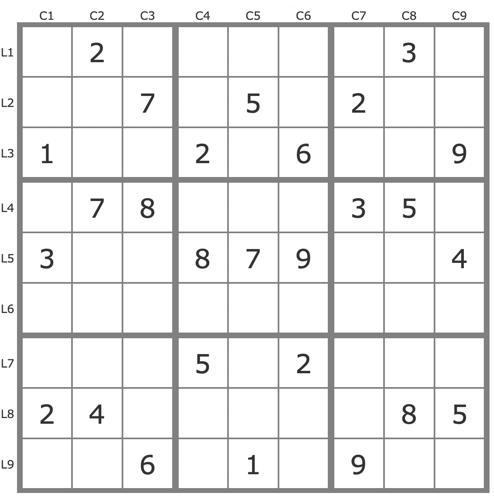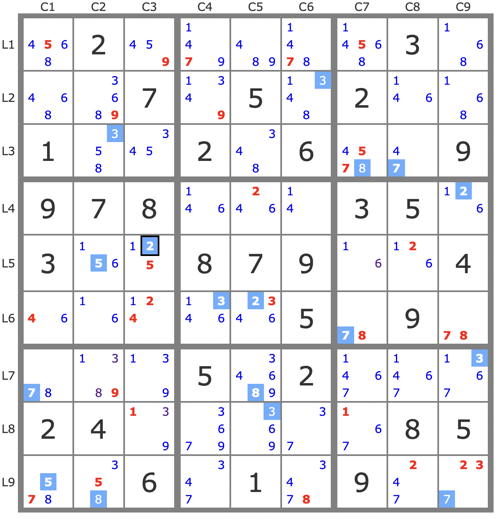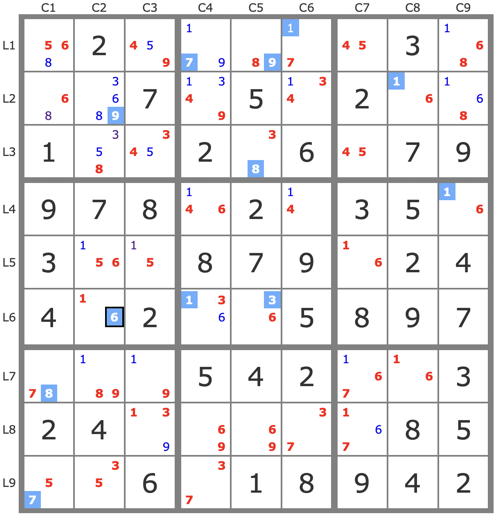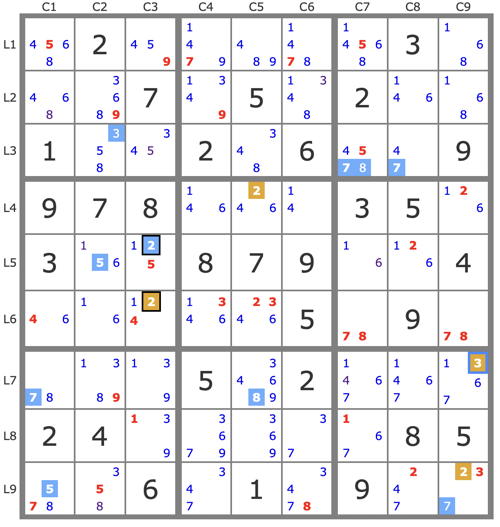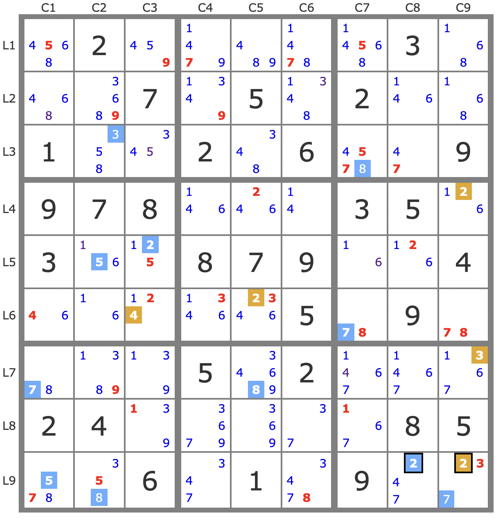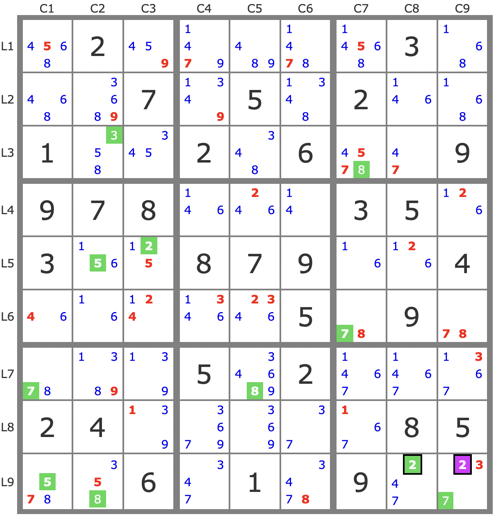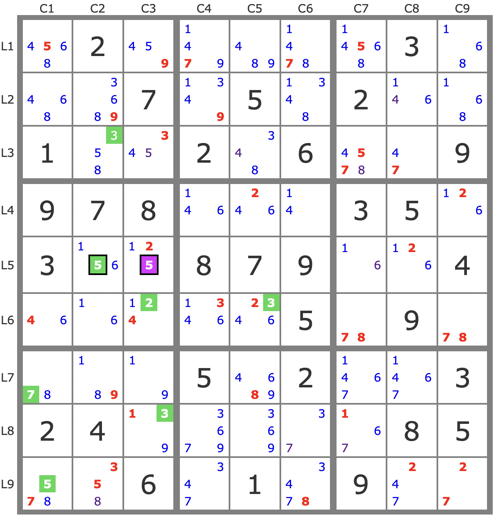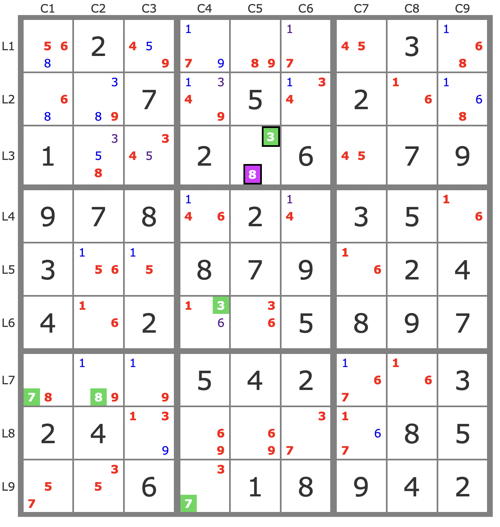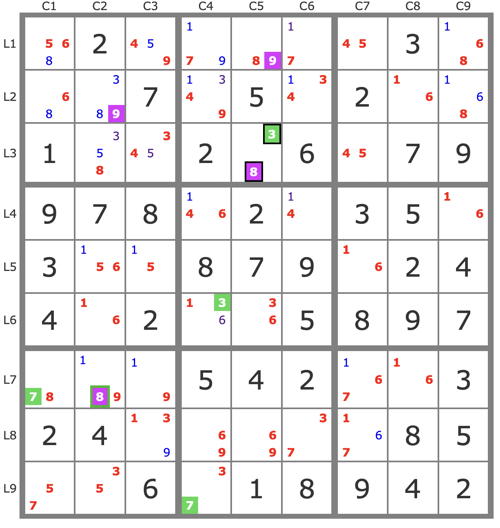Hi all,
As I said, here is my resolution presented in several ways for Denis, hoping that he will understand how TDP can be declined and that it has nothing to do with copying his techniques.
1) We can solve with a minimum of steps by looking for invalid tracks, as follows.
I specify that here the chaining is written with a memory effect, i.e. ->A indicates that the positioning of A depends on that of the previous candidates ->.
P(2r5C3) : 2r5c3->5r5c2->5r9c1->7r7c1->3r3c2->8r9c2->8r7c5->8r3c7->7r6c7->7r3c8->7r9c9->3r7c9->2r4c9->2r6c5->3r6c4->3r2c6->3r8c5->... => contradiction (no 3 possible in B7) => r6c3=6 + basic techniques (TB).
P(6r6c2) : 6r6c2->3r6c5->1r6c4->1r4c9->1r2c8->1r1c6->7r1c4->7r9c1->8r7c1->8r3c5->9r1c5->9r2c2->... = > contradiction (no 8 possible in B1) => r6c2=1 and end with TB (singles).
This method of solving is what Denis calls T&E. I only use it to determine the difficulty level of the puzzle, which I call the TDP level.
This kind of resolution has earned me criticism on this forum, which has led me to avoid it.
2) One can also solve by using conjugate tracks. This is what I sometimes do to explain to my readers how to solve in several steps that do not necessarily involve searching for invalid leads. For example, for a first step :
P(2r5c3) : 2r5c3->5r5c2->5r9c1->7r7c1->3r3c2->8r9c2->8r7c5->8r3c7->7r3c8->7r6c7->7r9c9->
3r7c9->...
P(2r6c3) : 2r6c3->2r4c5->2r9c9->
3r7c9->...
=> r7c9=3
The property used here is that any common candidate of two conjugate tracks is a solution of its cell.
But I could also have used P(2r9c9) and P(2r9c8) which are conjugate tracks, like this:
P(2r9c9) : 2r9c9->2r5c8->2r6c3->4r6c1->...
P(2r9c8) : 2r9c8->2r5c3->5r5c2->5r9c1->7r7c1->3r3c2->8r9c2->8r7c5->8r3c7->7r6c7->7r9c9->...
=> r9c9≠3 => r7c9=3.
The property used here is that any candidate who sees both a candidate from each of the conjugate tracks can be eliminated.
But I could have also, considered P(2r9c8) as the anti-track P'(2r9c9) to eliminate 3r9c9 as I usually do on this forum since 3r9c9 sees both 2r9c9 and a candidate of P'(2r9c9), developing only the anti-track.
Etc, etc ...
3) Here is the end of my resolution of all the resolutions I could make, after placing 3r7c9.
P'(5r5c3) : (-5r5c3) => [5r5c2->5r9c1->7r7c1->8r79c2]->3r3c2->3r8c3->3r6c5->2r6c3->.... => -2r5c3 => 2r6c3 +TB.
P'(8r3c5) : (-8r3c5) => 3r3c5->3r6c4->7r9c4->7r7c1->8r7c2->... => -8r3c2 => r3c5=8 , stte.
But I can also find this result with two conjugate tracks :
P(8r3c5) : [8r3c5->9r3c5-> 9r2c2]->8r7c2->...
P(3r3c5) : 3r3c5->3r6c4->7r9c4->7r7c1->8r7c2->...
=> r7c2=8 =>r2c5=8, stte
This example shows that when I study a puzzle I find different ways of solving it with TDP, but in the end, when it comes to presenting one, I only retain the simplest one and not because I have copied anyone else.
Robert

